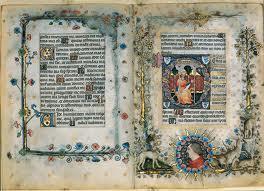Lombardy : Visconti Book of Hours

Visconti Book of Hours
Giovanni Dei Grassi (ca 1395)
Comissioned by Giangaleazzo Visconti
Illuminated Manuscript
The page from this manuscript I have chosen to research features a portrait of its commissioner from the first part of the book, Gian Galeazzo Visconti. This prayer book was begun in 1395 by artist Giovannino dei Grassi and finished in the late 1420s by Belbello da Pavia. The style of this particular page and Grassi in general is that of the International Gothic style while also calling upon classical traditions. Gian Galeazzo is pictured at the bottom of this page in profile, which is traditional of Roman coins. Surrounding him is text from Psalm 118. In the center of the illumination, where the text is, an image with the Visconti coat of arms on each corner is featured. This scene features King David, traditionally regarded as the author of the psalms. At the bottom and top of the page are scenes of Gian Galeazzo’s hound dogs attacking other animals. Grassi is known to have done studies of animals, and these images are likely derived from his previous sketches.
Gian Galeazzo Visconti is considered to be the greatest Italian patron of illuminated manuscripts in the second half of the century. He is known for establishing Pavia and Milan as major European centers for the production of illuminated manuscripts through his commissioning of several volumes featuring themes of flora, fauna, medicine and the seasons of the year. Though the entire Visconti family is regarded as notable patrons of manuscript illuminations, Gian Galeazzo ranks as one of the most notable of his time.
Around the same time the Visconti Book of Hours was commissioned, extreme measures were in motion to take control of the rapidly spreading Black Death. Duke Bernabo Visconti was the first to enact strict quarantine laws in the city of Milan. After Bernabo’s death, Gian Galeazzo took over Plague control in 1399. During his reign as Military leader and administrator in Milan, Gian Galeazzo formed a system of very strict protocol for the Black Death that was upheld and later became the core program 60 years later for Plague control in Milan.
